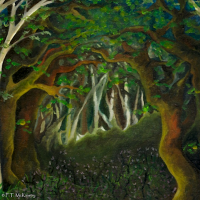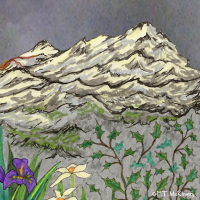Natural landscapes are an integral part of any good tale, a multidimensional backdrop that gives life to the imagination. Like music, natural settings fall in patterns, creating moods, thoughts, and impressions by virtue of what they are.
Inspired by mountains, forests and all things that grow, the world of Ealiron is richly illustrated with root and leaf, both literally and through ancient traditions of magic honoring the correspondences between plants, trees, animals, color, and sound. Here we will journey through old forests, wise trees, enchanted gardens, fragile flowers, and mountains.
Forests
It was the forest’s fault. Those two handsome woodcutters. An evil place, the forest, everyone knew it, full of temptations and imps… ~ Tanith Lee
 Forests get a bad rap in fairy tales. When they are portrayed at their most beautiful, that is when we’d best beware. While a deep, dark wood is an excellent metaphor for the shadowy realms of the mind, there is no denying that forests have a soul. The presence of trees creates a feeling of awe and stimulates the imagination.
Forests get a bad rap in fairy tales. When they are portrayed at their most beautiful, that is when we’d best beware. While a deep, dark wood is an excellent metaphor for the shadowy realms of the mind, there is no denying that forests have a soul. The presence of trees creates a feeling of awe and stimulates the imagination.
The following excerpt describes an ancient forest called Eusiron’s Haunt, so called because a god of that name is consciously aware as the soul of the wood. Some say he protects the palace above. Others say it amuses him. To a wizard named Lorth, the Haunt is particularly uncanny.
In this forest, he could have seen a ghost, a wolf or a dragon. He could have seen something as fearsome as a sioros, an immortal man-shaped predator with tall black wings, fangs and no tolerance whatsoever for anything intruding on its territory. He had heard stories of things like that. Efar had told him that whatever one saw here depended on who that person was and with what purpose. Had his intentions been different—hostile, for example—the forest might have changed not only in appearance, but also in what lived here. It would not change in a linear sense, as if monsters or armies suddenly flooded from the trees. Time-space itself would change. From one moment to the next, a forest slightly unnerving would become, from the beginning of time, a forest patrolled by sioros, dragons and Maern knew what else. The ancient oak tree that moved from one side of the path to the other would become a monster with its own history, intentions and no one to stop it, as most likely no palace would tower above the tops of the trees, with an army inside to come to the rescue. ~ The Hunter’s Rede
Trees
“Listen to the trees talking in their sleep,” she whispered, as he lifted her to the ground. “What nice dreams they must have!” ~ L.M. Montgomery, Anne of Green Gables
 There are forests, and then there are trees. After all, you can miss one for the other. Every kind of tree has its own personality: the texture of its bark, how it roots, the shape of its leaves, or the sound wind makes when it blows through the boughs. The spirits of trees are traditionally associated with qualities such as elemental forces, seasons, colors and life cycles. In Ealiron, different trees correspond with the twelve orders of the Keepers of the Eye, wizards and craftspeople who maintain balance in the world’s energies.
There are forests, and then there are trees. After all, you can miss one for the other. Every kind of tree has its own personality: the texture of its bark, how it roots, the shape of its leaves, or the sound wind makes when it blows through the boughs. The spirits of trees are traditionally associated with qualities such as elemental forces, seasons, colors and life cycles. In Ealiron, different trees correspond with the twelve orders of the Keepers of the Eye, wizards and craftspeople who maintain balance in the world’s energies.
There exists a very rare tree in Ealiron called an Om tree. Its seeds are planted by gods, and it lives for many centuries. An Om tree grows in the palace of Eusiron, and is greatly loved by the Mistress of the realm.
The Mistress approached the tree and placed her hands upon it. “Hai love,” she said softly. A bough rustled, lowered down and brushed against the small of her back like a caress. Lorth had once heard about this, though he had disregarded it as a tale warriors tell over fire and drink in the wee hours. They called it the Om tree. Seeded by the stars, the tree rooted deeply into the iomor beneath the palace. It was said the tree knew things, could tell truth from lies, and saw through its bark and limbs to the very heart of the Old One herself. ~ The Hunter’s Rede
Gardens
Gardens are not made by singing “Oh, how beautiful!” and sitting in the shade. ~ Rudyard Kipling, Complete Verse
 A garden is a lively place. Plants reach into the soil and up to the sun with chaotic abandon, and yet there is balance; things emerge only in their time, and when the shadows of summer grow long, the garden bows out gracefully. I find joy in participating in this. For my part, I arrange things in nice patterns and keep order while at the same time nurturing the chaos.
A garden is a lively place. Plants reach into the soil and up to the sun with chaotic abandon, and yet there is balance; things emerge only in their time, and when the shadows of summer grow long, the garden bows out gracefully. I find joy in participating in this. For my part, I arrange things in nice patterns and keep order while at the same time nurturing the chaos.
Tansel of Loralin is born of three generations of wisewomen. Gardening is in her blood…but she has yet to learn the most profound secret her garden is keeping.
Tansel loved her garden with all her heart. It surrounded the cottage and spread out beneath the edges of the forest like a wild thing, singing. She grew things for eating, seasoning and healing; things that smelled pretty, attracted butterflies, birds, bees, and cats; she grew things for the shapes of their leaves, the way the sun and moon shone upon a petal or a stalk, or the way one thing grew beside another, tangling high and low in arches, tendrils and delicate patterns. Some plants loved the high, bright sun; others preferred the shadows beneath evergreen trees, or water caressing their roots. Tansel grew things she simply liked the names of. Things no one knew the names of.
Few could have said exactly what grew in Tansel’s garden. Not even she knew, from season to season. The garden had a rhythm of its own, a balance that took care of itself. ~ The Winged Hunter
Flowers
With freedom, books, flowers, and the moon, who could not be happy? ~ Oscar Wilde
 Flowers are spectacular creations. Brilliant, intense, fragile, and fleeting, flowers capture the essence of sensitive and yet enduring things. When a flower blooms, we know something important is happening.
Flowers are spectacular creations. Brilliant, intense, fragile, and fleeting, flowers capture the essence of sensitive and yet enduring things. When a flower blooms, we know something important is happening.
In this excerpt, an immortal being is having a crisis for which simple things in nature, including flowers, offer some perspective.
The swamp kept singing, falling in harmony to her tears. Life abounded here; it could not grow fast enough. Snakes curled in the trees, muskrats ambled through the cattails to loam hollows, colorful birds fluttered about and bugs crept over rotting logs. A red hind drank from a pool. Rain tapped softly on emerald leaves and touched the flowers, causing them to bob around as if laughing. ~ “The Fifth Verse,” Wizards, Woods and Gods
Mountains
The mountains were his masters. They rimmed in life. They were the cup of reality, beyond growth, beyond struggle and death. They were his absolute unity in the midst of eternal change. ~ Thomas Wolfe, Look Homeward, Angel
 An interesting thing about mountains is how they vary in character from one range to the next. There are old mountains, worn down by time and dark in their knowing; young, spectacular mountains crowned by unmelting snow; lush green jungle mountains; and rugged, arid ones. The creatures that live in the mountains know them.
An interesting thing about mountains is how they vary in character from one range to the next. There are old mountains, worn down by time and dark in their knowing; young, spectacular mountains crowned by unmelting snow; lush green jungle mountains; and rugged, arid ones. The creatures that live in the mountains know them.
For those living in the valleys, the surrounding mountains exude mystery, as in this excerpt:
The hermit spoke of a temple in the north, at the base of Math’s Eye, the mountain range that protected the realm. He said the War God slept there, beneath five points, five lines and a raven’s eye. So said the old tales. So said the mad. No one else spoke of such things. ~ “The War God Sleeps,” Wizards, Woods and Gods
![]()
Nature as Muse: Warm and Furry
Nature as Muse: Creepy and Crawly
Nature as Muse: Water and Sky
© F.T. McKinstry 2013. All Rights Reserved.
You must be logged in to post a comment.